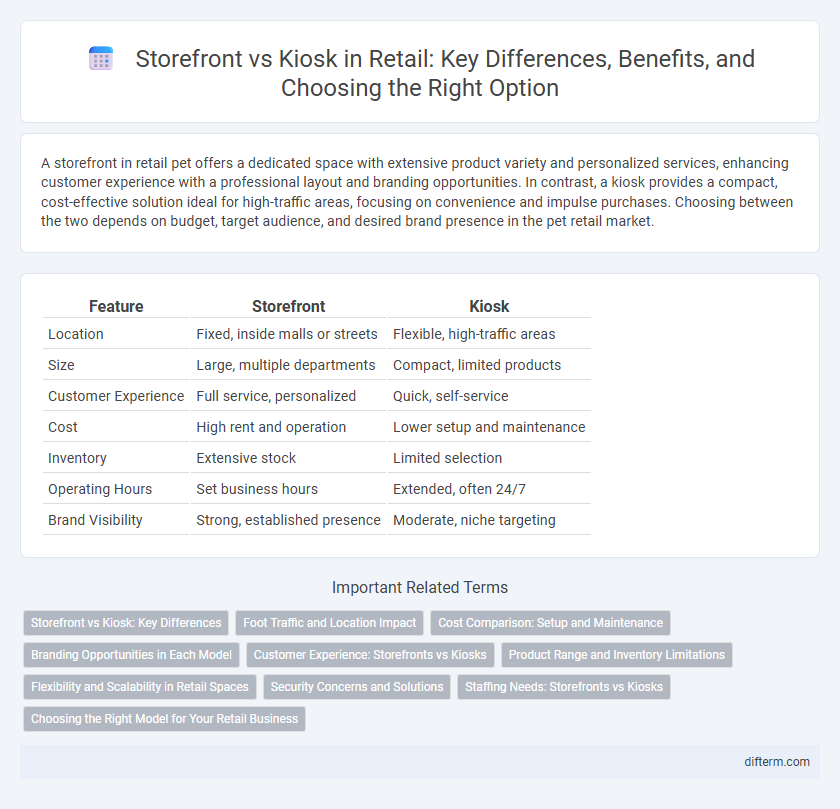A storefront in retail pet offers a dedicated space with extensive product variety and personalized services, enhancing customer experience with a professional layout and branding opportunities. In contrast, a kiosk provides a compact, cost-effective solution ideal for high-traffic areas, focusing on convenience and impulse purchases. Choosing between the two depends on budget, target audience, and desired brand presence in the pet retail market.
Table of Comparison
| Feature | Storefront | Kiosk |
|---|---|---|
| Location | Fixed, inside malls or streets | Flexible, high-traffic areas |
| Size | Large, multiple departments | Compact, limited products |
| Customer Experience | Full service, personalized | Quick, self-service |
| Cost | High rent and operation | Lower setup and maintenance |
| Inventory | Extensive stock | Limited selection |
| Operating Hours | Set business hours | Extended, often 24/7 |
| Brand Visibility | Strong, established presence | Moderate, niche targeting |
Storefront vs Kiosk: Key Differences
Storefronts provide a permanent retail space with larger inventory capacity and a more immersive brand experience compared to kiosks, which are smaller, often temporary units designed for high-foot-traffic areas. Kiosks offer lower setup costs and greater flexibility, making them ideal for testing new products or markets with limited investment. Retailers choose storefronts for long-term customer engagement and kiosks for quick, opportunistic sales boosts in dynamic environments.
Foot Traffic and Location Impact
Storefronts benefit from higher foot traffic due to their prominent locations on busy streets or shopping centers, making them ideal for attracting a wide range of customers. Kiosks, often situated in high-traffic areas like malls or transit hubs, leverage strategic placement to capture impulse buyers and enhance brand visibility in confined spaces. The impact of location in retail is critical; storefronts command larger spaces with greater visibility, while kiosks maximize location efficiency by targeting concentrated pedestrian flows.
Cost Comparison: Setup and Maintenance
Storefronts typically require higher initial setup costs, including leasing or purchasing retail space, interior design, and utilities, while kiosks demand lower upfront investment due to smaller physical footprints and simpler infrastructure. Maintenance expenses for storefronts encompass regular facility upkeep, security, and staffing, often surpassing kiosk costs that mainly involve basic cleaning and periodic restocking. Evaluating the cost efficiency of storefronts versus kiosks is crucial for retailers aiming to optimize their budget allocation and operational scalability.
Branding Opportunities in Each Model
Storefronts offer expansive branding opportunities with large signage, window displays, and customizable facades that create strong physical presence and enhance brand recognition. Kiosks provide focused, high-impact branding through compact design, digital screens, and strategic placement in high-traffic areas, enabling targeted customer engagement. Both models leverage unique spatial advantages to maximize brand visibility and influence consumer perception in retail environments.
Customer Experience: Storefronts vs Kiosks
Storefronts provide a spacious environment allowing customers to browse extensive product selections, fostering a tactile and immersive shopping experience that encourages longer visits. Kiosks offer convenience through quick, streamlined interactions often placed in high-traffic areas, catering to impulse purchases and immediate needs. The choice between storefronts and kiosks significantly impacts customer satisfaction by balancing depth of engagement with accessibility and speed.
Product Range and Inventory Limitations
Storefronts offer a broader product range with extensive inventory capacity, allowing retailers to showcase diverse merchandise and meet various customer needs. Kiosks, due to their limited physical space, typically carry a smaller, curated selection of high-demand or niche products, optimizing for quick sales and easy inventory management. Inventory replenishment cycles for kiosks are shorter and more frequent to maintain stock levels within space constraints.
Flexibility and Scalability in Retail Spaces
Storefronts offer greater flexibility by accommodating a wide range of product displays and personalized branding opportunities within larger retail spaces. Kiosks provide scalable solutions ideal for temporary or high-traffic areas, enabling quick setup and easy relocation without extensive infrastructure. Retailers balance storefronts and kiosks to optimize space utilization and adapt swiftly to changing consumer demands and market trends.
Security Concerns and Solutions
Storefronts face security concerns such as break-ins, shoplifting, and vandalism, necessitating robust alarm systems, surveillance cameras, and reinforced entry points. Kiosks, often located in high-traffic areas, require emphasis on tamper-resistant designs, secure payment processing, and real-time monitoring to prevent theft and fraud. Implementing end-to-end encryption for transactions and integrating biometric access controls enhances security for both storefronts and kiosks, mitigating risks in retail environments.
Staffing Needs: Storefronts vs Kiosks
Storefronts generally require a larger, more specialized staff including managers, sales associates, and security personnel to manage the diverse customer interactions and inventory. Kiosks operate efficiently with minimal staffing, often needing only one or two employees due to their limited size and product range. Staffing costs for storefronts are significantly higher, impacting overall operational expenses compared to kiosks.
Choosing the Right Model for Your Retail Business
Selecting between a storefront and a kiosk depends on your retail business goals, target audience, and budget constraints. Storefronts offer extensive product displays and brand presence, ideal for businesses seeking long-term customer engagement, while kiosks provide cost-effective, high-traffic placement suitable for impulse purchases and limited product ranges. Analyze foot traffic patterns, product types, and operational costs to determine the optimal retail model that maximizes sales and enhances customer experience.
Storefront vs Kiosk Infographic

 difterm.com
difterm.com